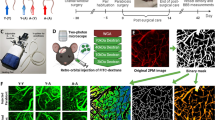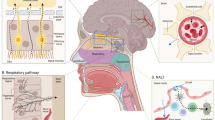Abstract
18β-Glycyrrhetinic acid (GA) is a major metabolite of glycyrrhizin (GL), which is one of the components of glycyrrhiza root, a constituent herb of the traditional Japanese medicine yokukansan. It is well known that most GL is metabolized to GA in the intestine by bacteria. A previous in vitro study using cultured rat cortical astrocytes suggested that GA activates glutamate transport, which is a putative mechanism of the psychotropic effect of yokukansan. To activate the glutamate transport in the brain, GA must be absorbed into the blood after oral administration of yokukansan and then cross the blood–brain barrier (BBB) to reach the brain. However, there is no data on the BBB permeability of GA derived from yokukansan. In the present study, the BBB permeability of GA was investigated in both in vivo and in vitro studies. In the in vivo study, GA was detected in the plasma, brain, and cerebrospinal fluid of rats orally administered yokukansan. In the in vitro study using a BBB model composed of co-culture of endothelial cells, pericytes, and astrocytes, the permeability rate and apparent permeability coefficient of GA were found to be 13.3 ± 0.5 % and 16.5 ± 0.7 × 10−6 cm/s. These in vivo and in vitro results suggest that GL in orally administered yokukansan is absorbed into the blood as GA, and then reaches the brain through the BBB. This evidence further supports the possibility that GA is an active component in the psychotropic effect of yokukansan.



Similar content being viewed by others
References
Abbott NJ, Rönnbäck L, Hansson E (2006) Astrocyte–endothelial interactions at the blood–brain barrier. Nat Rev Neurosci 7:41–53
Akao T, Hayashi T, Kobashi K, Kanaoka M, Kato H, Kobayashi M, Takeda S, Oyama T (1994) Intestinal bacterial hydrolysis is indispensable to absorption of 18β-glycyrrhetic acid after oral administration of glycyrrhizin in rats. J Pharm Pharmacol 46:135–137
Cantelli-Forti G, Maffei F, Hrelia P, Bugamelli F, Bernardi M, D’Intino P, Maranesi M, Raggi MA (1994) Interaction of licorice on glycyrrhizin pharmacokinetics. Environ Health Perspect 102:65–68
Cecchelli R, Berezowski V, Lundquist S, Culot M, Renftel M, Dehouck MP, Fenart L (2007) Modelling of the blood–brain barrier in drug discovery and development. Nat Rev Drug Discov 6:650–661
De Vries HE, Blom-Roosemalen MCM, De Boer AG, Van Berkel TJC, Breimer DD, Kuiper J (1996) Effect of endotoxin on permeability of bovine cerebral endothelial cell layers in vitro. J Pharm Exp Ther 277:1418–1423
Deli MA, Ábrahám CS, Kataoka Y, Niwa M (2005) Permeability studies on in vitro blood–brain barrier models: physiology, pathology, and pharmacology. Cell Mol Neurobiol 25:59–127
Gaillard PJ, De Boer AG (2000) Relationship between permeability status of the blood–brain barrier and in vitro permeability coefficient of a drug. Eur J Pharm Sci 12:95–102
Gaillard PJ, De Boer AG, Breimer DD (2003) Pharmacological investigations on lipopolysaccharide-induced permeability changes in the blood–brain barrier in vitro. Microvasc Res 65:24–31
Hattori M, Sakamoto T, Yamagishi T, Sakamoto K, Konishi K, Kobashi K, Namba T (1985) Metabolism of glycyrrhizin by human intestinal flora. II. Isolation and characterization of human intestinal bacteria capable of metabolizing glycyrrhizin and related compounds. Chem Pharm Bull 33:210–217
Ikarashi Y, Iizuka S, Imamura S, Yamaguchi T, Sekiguchi K, Kanno H, Kawakami Z, Yuzurihara M, Kase Y, Takeda S (2009) Effects of Yokukansan, a traditional Japanese medicine, on memory disturbance and behavioral and psychological symptoms of dementia in thiamine-deficient rats. Biol Pharm Bull 32:1701–1709
Imamura S, Tabuchi M, Kushida H, Nishi A, Kanno H, Yamaguchi T, Sekiguchi K, Ikarashi Y, Kase Y (2011) The blood–brain barrier permeability of geissoschizine methyl ether in Uncaria hook, a galenical constituent of the traditional Japanese medicine yokukansan. Cell Mol Neurobiol 31:787–793
Iwasaki K, Satoh-Nakagawa T, Maruyama M, Monma Y, Nemoto M, Tomita N, Tanji H, Fujiwara H, Seki T, Fujii M, Arai H, Sasaki H (2005) A randomized, observer-blind, controlled trial of the traditional Chinese medicine Yi-Gan San for improvement of behavioral and psychological symptoms and activities of daily living in dementia patients. J Clin Psychiatry 66:248–252
Jang EY, Choe ES, Hwang M, Kim SC, Lee JR, Kim SG, Jeon JP, Buono RJ, Yang CH (2008) Isoliquiritigenin suppresses cocaine-induced extracellular dopamine release in rat brain through GABAB receptor. Eur J Pharmacol 587:124–128
Joό F (1996) Endothelial cells of the brain and other organ systems: some similarities and differences. Prog Neurobiol 48:255–273
Kawakami Z, Kanno H, Ueki T, Terawaki K, Tabuchi M, Ikarashi Y, Kase Y (2009) Neuroprotective effects of yokukansan, a traditional Japanese medicine, on glutamate-mediated excitotoxicity in cultured cells. Neuroscience 159:1397–1407
Kawakami Z, Ikarashi Y, Kase Y (2010) Glycyrrhizin and its metabolite 18β-glycyrrhetinic acid in glycyrrhiza, a constituent herb of yokukansan, ameliorate thiamine deficiency-induced dysfunction of glutamate transport in cultured rat cortical astrocytes. Eur J Pharmacol 626:154–158
Kis B, Deli MA, Kobayashi H, Ábrahám CS, Yanagita T, Kaiya H, Isse T, Nishi R, Gotoh S, Kangawa K, Wada A, Greenwood J, Niwa M, Yamashita H, Ueta Y (2001) Adrenomedullin regulates blood–brain barrier functions in vitro. Neuroreport 12:4139–4142
Mizukami K, Asada T, Kinoshita T, Tanaka K, Sonohara K, Nakai R, Yamaguchi K, Hanyu H, Kanaya K, Takao T, Okada M, Kudo S, Kotoku H, Iwakiri M, Kurita H, Miyamura T, Kawasaki Y, Omori K, Shiozaki K, Odawara T, Suzuki T, Yamada S, Nakamura Y, Toba K (2009) A randomized cross-over study of a traditional Japanese medicine (kampo), yokukansan, in the treatment of the behavioural and psychological symptoms of dementia. Int J Neuropsychopharmacol 12:191–199
Monji A, Takita M, Samejima T, Takaishi T, Hashimoto K, Matsunaga H, Oda M, Sumida Y, Mizoguchi Y, Kato T (2009) Effect of yokukansan on the behavioral and psychological symptoms of dementia in elderly patients with Alzheimer’s disease. Prog Neuropsychopharmacol Biol Psychiatry 33:308–311
Nakagawa S, Deli MA, Nakao S, Honda M, Hayashi K, Nakaoke R, Kataoka Y, Niwa M (2007) Pericytes from brain microvessels strengthen the barrier integrity in primary cultures of rat brain endothelial cells. Cell Mol Neurobiol 27:687–694
Nakagawa S, Deli MA, Kawaguchi H, Shimizudani T, Shimono T, Kittel Á, Tanaka K, Niwa M (2009) A new blood–brain barrier model using primary rat brain endothelial cells, pericytes and astrocytes. Neurochem Int 54:253–263
Redzic Z (2011) Molecular biology of the blood–brain and the blood–cerebrospinal fluid barriers: similarities and differences. Fluids Barriers CNS 8:3
Takeda S, Ishihara K, Wakui Y, Amagaya S, Maruno M, Akao T, Kobashi K (1996) Bioavailability study of glycyrrhetic acid after oral administration of glycyrrhizin in rats; relevance to the intestinal bacterial hydrolysis. J Pharm Pharmacol 48:902–905
Veszelka S, Pásztói M, Farkas AE, Krizbai I, Dung NTK, Niwa M, Ábrahám CS, Deli MA (2007) Pentosan polysulfate protects brain endothelial cells against bacterial lipopolysaccharide-induced damages. Neurochem Int 50:219–228
Wang Z, Kurosaki Y, Nakayama T, Kimura T (1994) Mechanism of gastrointestinal absorption of glycyrrhizin in rats. Biol Pharm Bull 17:1399–1403
Zlokovic BV (2008) The blood–brain barrier in health and chronic neurodegenerative disorders. Neuron 57:178–201
Author information
Authors and Affiliations
Corresponding author
Rights and permissions
About this article
Cite this article
Tabuchi, M., Imamura, S., Kawakami, Z. et al. The Blood–Brain Barrier Permeability of 18β-Glycyrrhetinic Acid, a Major Metabolite of Glycyrrhizin in Glycyrrhiza Root, a Constituent of the Traditional Japanese Medicine Yokukansan . Cell Mol Neurobiol 32, 1139–1146 (2012). https://doi.org/10.1007/s10571-012-9839-x
Received:
Accepted:
Published:
Issue Date:
DOI: https://doi.org/10.1007/s10571-012-9839-x




